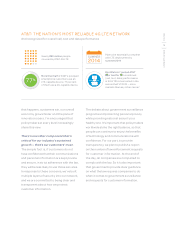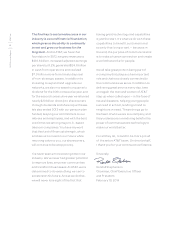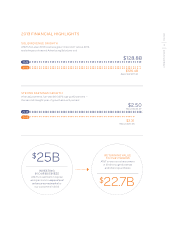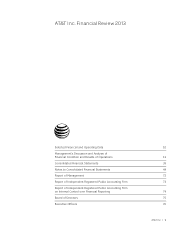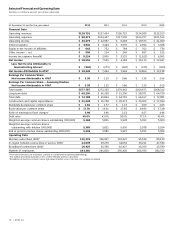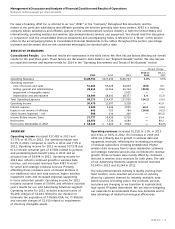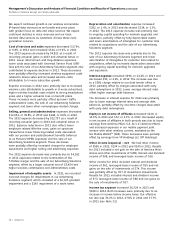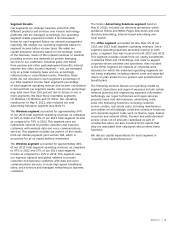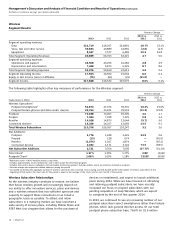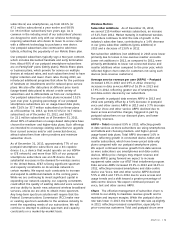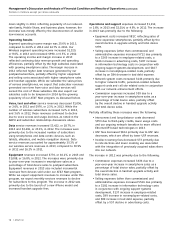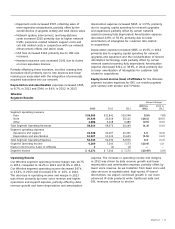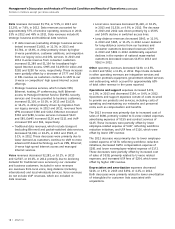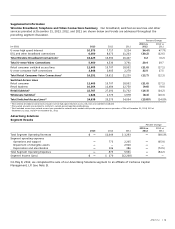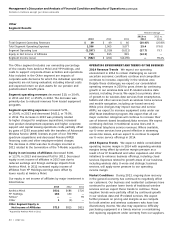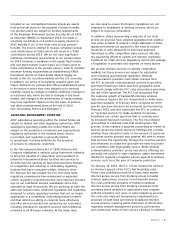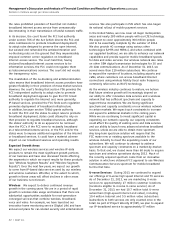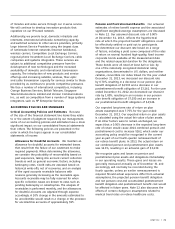AT&T Wireless 2013 Annual Report Download - page 17
Download and view the complete annual report
Please find page 17 of the 2013 AT&T Wireless annual report below. You can navigate through the pages in the report by either clicking on the pages listed below, or by using the keyword search tool below to find specific information within the annual report.
AT&T Inc. | 15
Wireless Metrics
Subscriber Additions As of December 31, 2013,
we served 110.4 million wireless subscribers, an increase
of 3.2% from 2012. Market maturity in traditional wireless
subscribers continues to limit the rate of growth in the
industry’s subscriber base, contributing to a 1.4% decrease
in our gross subscriber additions (gross additions) in
2013 and a decrease of 13.0% in 2012.
Net subscriber additions (net additions) in 2013 were lower
primarily due to losses in low-revenue reseller accounts.
Lower net additions in 2012, as compared to 2011, were
primarily attributable to lower net connected device and
reseller additions when compared to the prior year, which
reflected higher churn rates for customers not using such
devices (zero-revenue customers).
Average service revenue per user (ARPU) – Postpaid
increased 1.6% in 2013 and 1.9% in 2012, driven by
increases in data services ARPU of 16.9% in 2013 and
17.9% in 2012, reflecting greater use of smartphones
and data-centric devices by our subscribers.
The growth in postpaid data services ARPU in 2013 and
2012 was partially offset by a 5.0% decrease in postpaid
voice and other service ARPU in 2013 and a 3.7% decrease
in 2012. Voice and other service ARPU declined due to
lower access and airtime charges, triggered in part by
postpaid subscribers on our discount plans, and lower
roaming revenues.
ARPU – Total increased 0.9% in 2013, reflecting growth
in data services as more subscribers are using smartphones
and tablets and choosing medium- and higher-priced
usage-based data plans. Total ARPU decreased 1.6% in
2012, reflecting growth in connected device, tablet and
reseller subscribers, which have lower-priced data-only
plans compared with our postpaid smartphone plans.
We expect continued revenue growth from data services
as more subscribers use smartphones and data-centric
devices. While price changes may impact revenue and
service ARPU, going forward we expect to increase
equipment sales under our AT&T Next installment program.
Data services ARPU increased 15.1% in 2013 and 16.1% in
2012, reflecting increased smartphone and data-centric
device use. Voice, text and other service ARPU declined
5.5% in 2013 and 7.9% in 2012 due to voice access and
usage trends and a shift toward a greater percentage of
data-centric devices. We expect continued pressure on
voice, text and other service ARPU.
Churn The effective management of subscriber churn is
critical to our ability to maximize revenue growth and to
maintain and improve margins. While the postpaid churn
rate was lower in 2013, the total churn rate was up slightly
in 2013, reflecting increased competition, especially for
price-conscious customers. Total and postpaid churn were
subscribers) use smartphones, up from 69.6% (or
47.1million subscribers) a year earlier and 58.5%
(or 39.4million subscribers) two years ago. As is
common in the industry, most of our subscribers’ phones
are designed to work only with our wireless technology,
requiring subscribers who desire to move to a new carrier
with a different technology to purchase a new device.
Our postpaid subscribers also continued to add more
tablets, reflecting the popularity of our Mobile Share plan.
Our postpaid subscribers typically sign a two-year contract,
which includes discounted handsets and early termination
fees. About 90% of our postpaid smartphone subscribers
are on FamilyTalk® plans (family plans), Mobile Share plans
or business plans, which provide for service on multiple
devices at reduced rates, and such subscribers tend to have
higher retention and lower churn rates. During 2013, we
introduced additional programs that allow for the purchase
of handsets on installments and for reduced-price service
plans. We also offer data plans at different price levels
(usage-based data plans) to attract a wide variety of
subscribers and to differentiate us from our competitors.
Our postpaid subscribers on data plans increased 10.2%
year over year. A growing percentage of our postpaid
smartphone subscribers are on usage-based data plans,
with 72.6% (or 37.7 million subscribers) on these plans
as of December 31, 2013, up from 67.4% (or 31.7 million
subscribers) as of December 31, 2012, and 56.0%
(or 22.1million subscribers) as of December 31, 2011.
About 80% of subscribers on usage-based data plans have
chosen the medium- and higher-data plans. Such offerings
are intended to encourage existing subscribers to upgrade
their current services and/or add connected devices,
attract subscribers from other providers and minimize
subscriber churn.
As of December 31, 2013, approximately 77% of our
postpaid smartphone subscribers use a 4G-capable
device (i.e., a device that would operate on our HSPA+
or LTEnetwork), and more than 50% of our postpaid
smartphone subscribers use an LTE device. Due to
substantial increases in the demand for wireless service
in the United States, AT&T is facing significant spectrum
and capacity constraints on its wireless network in
certain markets. We expect such constraints to increase
and expand to additional markets in the coming years.
While we are continuing to invest significant capital in
expanding our network capacity, our capacity constraints
could affect the quality of existing data and voice services
and our ability to launch new, advanced wireless broadband
services, unless we are able to obtain more spectrum.
Any long-term spectrum solution will require that the
Federal Communications Commission (FCC) make new
or existing spectrum available to the wireless industry to
meet the expanding needs of our subscribers. We will
continue to attempt to address spectrum and capacity
constraints on a market-by-market basis.


